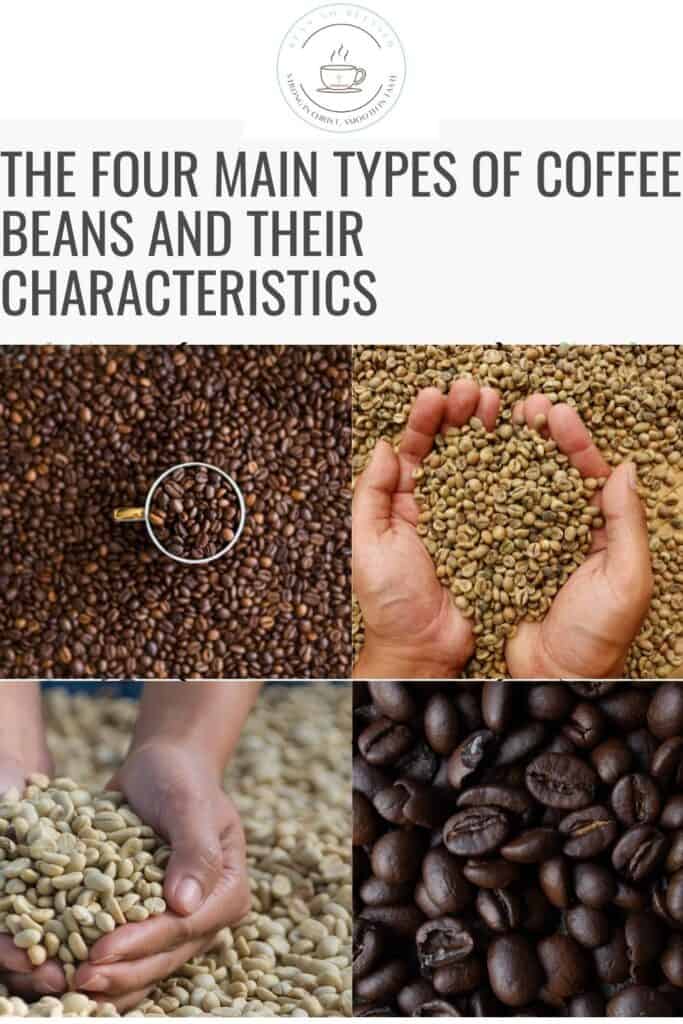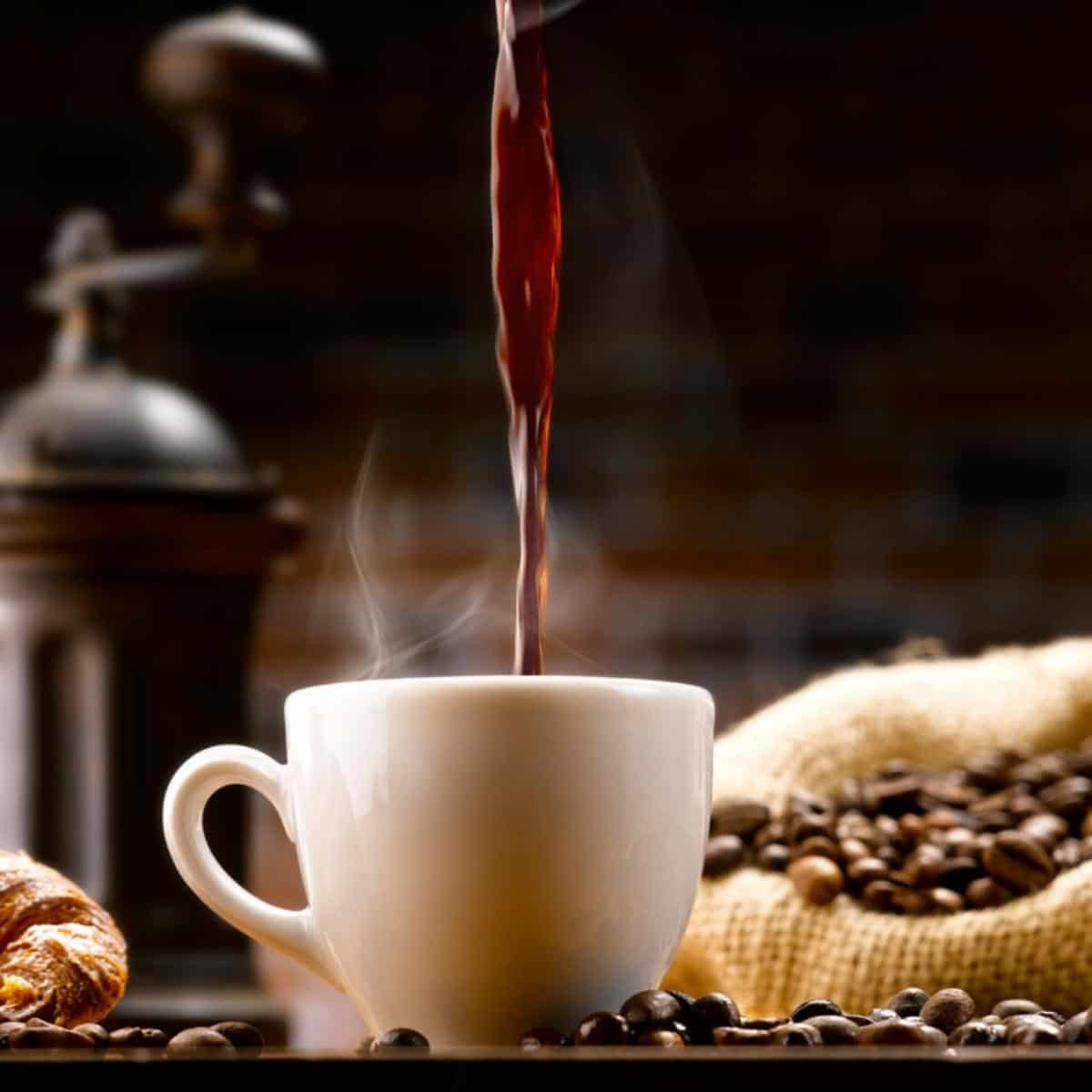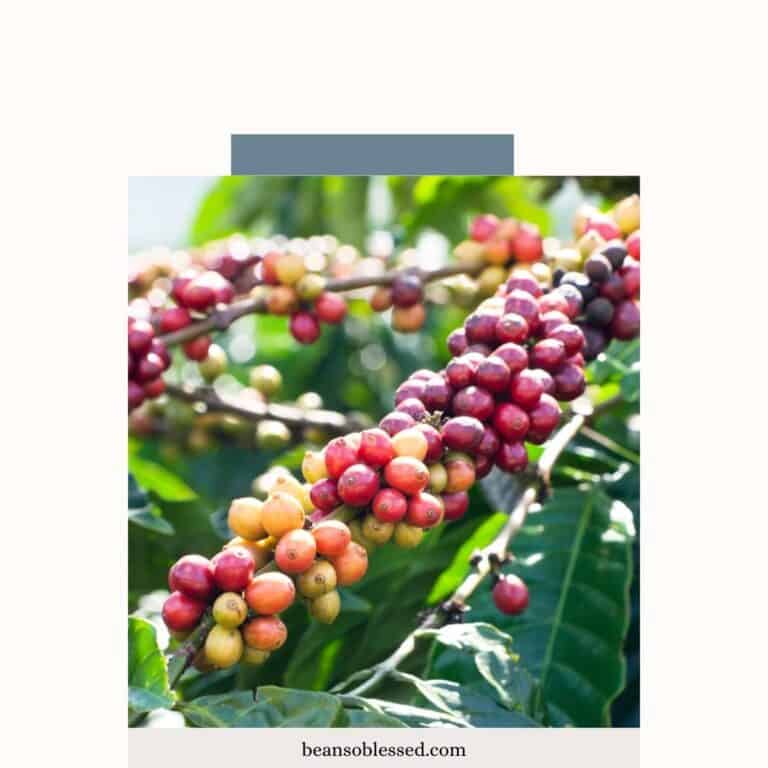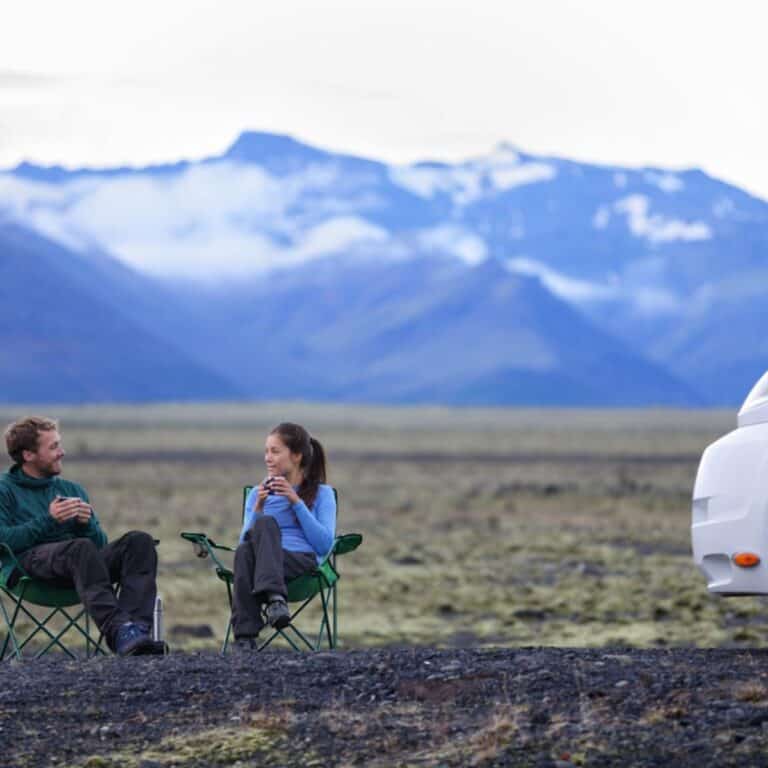The Four Main Types of Coffee Beans and Their Characteristics
Are you a coffee-lover, too?
After you have enjoyed your morning cup of joe, it’s likely that the last thing on your mind is the different types of coffee beans, but truly, it is important to know when choosing the best coffee for you. And, a rather fascinating topic!
When we think about how coffee is categorized and marketed, one thing that usually comes to mind is roasting profiles or source of origin. This information can be helpful in identifying what type of drink you’re going for with your favorite roast but it doesn’t tell the whole story! In this post, we’ll take an even closer look at each of the types of coffee beans and their characteristics.
Before we dive into the different types of coffee beans, let’s start with the basics. What exactly IS a coffee bean?
A coffee bean is the seed found in a coffee plant’s cherry or “fruit” of a coffee plant. Unlike most fruits we know of, the coffee cherry is unique in that we discard the outer portion and keep the pit, and roast it.
Ok, so now that we know what a coffee bean is, let’s look at the three (well, maybe four, but you’ll soon learn what we mean by that) main types of coffee beans.

Three (or Four!) Main Types of Coffee Beans
The four main coffee types of coffee beans are Arabica, Liberica, Robusta, and Excelsa. Each of them has vastly different flavor profiles. The characteristics change even more as they are harvested, processed, and roasted.
Arabica Coffee Beans (Coffea arabica)
As you walk through the supermarket, or even at your local coffee shop, you have probably noticed that some, if not all of the bags are marked “Arabica Coffee” or “Arabica Beans” on them. While there are several main types of coffee beans, Arabica is by far the most common. It actually accounts for 60 – 80% (depending on the source of data) of coffee produced globally.
These delicious and popular beans originated many centuries ago in the highlands of Ethiopia, and are considered by many coffee experts to be the first coffee beans ever consumed! The name Arabica probably originates from the beans’ extreme popularity in 7th-century Arabia, what we know today as Yemen.
The Flavor Profile of Arabica Coffee Beans
Arabica coffee beans are considered the most high-quality variety of the four main types of coffee beans. Known for their smooth, complex flavor and distinct lack of bitterness, they are low in caffeine and their smooth taste is aromatic and delicious.
Their taste tends to be sweeter with a medium body and several layers of flavor. One of the reasons that this type of coffee bean currently dominates the market, especially the specialty coffee market.
There are many different flavors to be discovered in a bag of Arabica beans depending on where they are grown – from earthy Indonesian and floral Ethiopian. If you want your taste buds amazed, pick up some single-origin coffee.
Their subtleties are best revealed when brewed pour-over style, which lets their flavor complexities shine through more than espresso or immersion methods.
The popular but sensitive bean is known for having its taste diminished when served cold or blended with milk, however, most people won’t notice the difference in their drink as many add additional flavors that enhance their favorite choice of coffee drink!

The Growing of Arabica Coffee Beans
Coffea Arabica plants thrive when they’re grown at higher elevations with plenty of rain, well-draining soil, and natural shade. The environment they are grown in can easily influence the beans as can wide temperature fluctuations. They do well in volcanic soil which is also rich in minerals.
Effectively growing Arabica coffee beans outside of the above-listed conditions can be both challenging and resource-intensive.
Because these types of coffee beans require precise conditions, thus harder to grow, they are pricier than some of the other types of coffee beans.
Mostly all the different types of coffee beans are grown in what is termed the “Bean Belt”. It is an area between the Tropics of Cancer and Capricorn and encompasses 50 countries around the world.
Arabica coffee bean plants are smaller plants, measuring between 8 and 15 feet when fully grown.
The Coffee arabica bean species is particularly prone to fungal diseases (Coffee Leaf Rust (CLR), Coffee Berry Disease (CBD), and Coffee Wilt Disease (CWD)) which makes farming on a large scale a challenge.
This propensity for fungal diseases makes farming only Arabica coffee beans dangerous as an outbreak of just one disease can quickly wipe out the entire crop.
This greatly increases the cost of the bean, but many coffee drinkers are happy to pay the premium price for the trade-off of the complex and sweeter test as well as the lower acidity that this type of coffee bean provides.
Brazil, known for its lush rainforest, is the world’s foremost exporter of Arabica beans.
Where can you buy Arabica beans?
The Bully Bean offers several different types of roasts using the Arabica bean. If you enjoy flavored coffees, you’ll want to try the Mocha or Pumpkin Spice.
For a heartier coffee, try the Italian Roast, which is blended with the Robusta coffee bean (explained in detail below).
Liberica Coffee Beans (Coffea liberica)
Liberica coffee is one of the four main coffee types grown globally. Never heard of it? It’s not surprising as it accounts for less than 2% of the world’s coffee crop. (Arabica is the most common, with Robusta coming in after that).
The robust and smoky flavor profile of Coffea liberica is prized by many for its bold smoky flavor and piquant floral aroma. Native to central and western Africa, thus its name, it is often mixed with other varieties of coffee beans to add body and complexity.
Undiscovered in Western civilization before the latter half of the 1800s, Liberica grew in popularity in Southeast Asia.
The history of this important type of coffee bean dates back centuries. It was first introduced to the Philippines in 17th-century but didn’t become a key crop until the late 19th century.
The Coffee rust disease hit Arabica plants in this region hard, but the Liberica survived. It was then introduced to Indonesia after their own problems with the coffee rust disease.
The Filipino people were the first to harvest and sell a noteworthy volume of Liberica plants, which helped their economy grow tremendously.
However, then the Philippines was a U.S. territory. As the Philippino economy grew, the nation declared its independence. This resulted in the United States imposing strong economic sanctions and cutting off supplies to the country. Ultimately this led to the downfall of the Liberica coffee bean in the global marketplace, as no other nations were ever able to step up and match the production that the Philippines had once pioneered.
Later, Liberica made its way to Malaysia with Javanese immigrants. (Fun Fact: The nickname for coffee, “java” is derived from where this coffee was grown on the island of Java, Indonesia).
Today the Liberica coffee bean makes up the majority of coffee crops in Malaysia (over 95%!) as the area is too low-lying for the production of good Arabica. In the Philippines and Indonesia, Liberica is just a small percentage of coffee grown, with both countries preferring the bolder taste of Robusta.
However, Liberica is not easily found in North American and European markets.

The Flavor Profile of the Liberica Coffee Bean
Among coffee enthusiasts, the Liberica coffee bean has a controversial and polarizing reputation for its wild inconsistency. Those who have tasted it either love it or hate it. There seems to be no in-between.
Those that favor it report an unusual, nutty, woody flavor and strong backbite on the finish. Those that don’t say it tastes like burnt garbage.
When grown well, it is a gorgeous coffee. It provides floral aromas, flavors of sweet stone fruit, and an unusual woody aftertaste. If grown with poor quality, the Liberica coffee beans’ same aromas can be too prominent and even repulsive. This explains the divisive nature of this bean.
Unlike other types of coffee beans, Liberica does not have an association or set of standards to judge this specialty coffee.
The largest of the three coffees, Liberica beans are instantly recognizable for their asymmetrical, teardrop shape. Interesting to note, though, that the Liberica coffee bean has the lowest caffeine content of the other types. – this bean’s caffeine content is lower than any others!
The Growing of Liberica Coffee Beans
Liberica coffee beans trees are the largest of the main three types of coffee beans. The trees can grow up to 56 feet tall! The beans are also larger, having a long, oval shape.
Liberica coffee trees, however, have a lower yield than Arabica or Robusta making them less effective as a crop. Their rarity, though, means they may be sold for a higher price than other types of coffee beans.
They’re grown in very hot and humid climates at low altitudes, limiting the production to scale for a global marketplace.
What Is Kapeng Barako?
Kapeng Barako, also called Barako coffee, is a variety of Liberica coffee beans grown only in the Philippines. The term “barako” is translated from the Tagalog word for “boar” or “stud bull” – a seemingly ideal name for the strong, unique flavor of Liberica beans. In some areas, the term “barako” can now refer to any coffee served strong.
The production of the Barako variety has declined over the years as farmers replace their trees with higher-yield varieties. In addition, younger coffee drinkers tend to prefer a smoother tasting coffee, leaving the strong Barako to the older generations.
Where can you buy Liberica beans?
Considered somewhat of an artifact from days gone by, kapeng barako is still available and found on the shelves of markets and served in cafes throughout the Phillipines. If you are outside of Southeast Asia, you are likely to find Barako coffee (or Liberica beans) only in a market that caters to the Filipino ex-pat community.
Robusta Coffee Beans (Coffea caniphora)
As mentioned above, most of the high-quality coffee in your local store carries the label “100% Arabica.” But what about the rest of them? With just a few percent made up of Liberica (or its offshoot, Excelsa), it’s almost certainly Robusta, which is the only other coffee that is grown commercially on a grand scale.
Robusta coffee beans are grown from the Coffea canephora plant. Coffea canephora became known as Coffea robusta or Robusta because it is the more robust of the main types of coffee beans. Robusta coffee makes up about 40% of the coffee grown globally.
Since the Robusta coffee bean is, well, robust, it is why it can be grown in a wider range of environments, making it less prone to disease. In spite of the fact that it has many advantages, people tend not to prefer Robusta because its flavors and aromas are less desirable.
While Robusta coffee beans are often considered lower quality than the famous Arabica, it is not always the case. There are a number of farmers and processors around the world working to develop high-quality Robusta beans and Robusta-Arabica hybrids. (At The Bully Bean Coffee, we sell some of these delicious roasted beans!)
Fun Fact: Robusta coffee beans contain 2.5% more caffeine than other types of coffee beans.
The Flavor Profile of the Robusta Coffee Bean
The Robusta bean is well known for its darker, earthier flavor and it’s most often dark roasted to better match its natural character.
Robusta coffee beans shine brightest when prepared as espresso. In fact, in Southern Italy, most espresso blends contain at least a portion of Robusta coffee beans.
They yield a richer crema than Arabica beans, and their naturally dark and earthy character is the perfect base for sweet steamed milk in drinks like lattes and cappuccinos, where the subtleties of an Arabica bean would be lost.
The beans also have a nice, smooth texture and many report that they even have a slight chocolate flavor to them. This makes them especially ideal with milk and sugar or as an iced coffee drink.
The Growing of the Robusta Coffee Bean
The Robusta coffee bean originated in Africa, purportedly in the Democratic Republic of Congo and Uganda. While it is still grown commercially in Africa, particularly in Uganda, Tanzania, and Cote d’Ivoire, growing of the Robusta coffee bean has expanded all over the world. The largest producer of Robusta is Vietnam, then Brazil as well as Indonesia.
This type of coffee bean grows best in a hot climate (70 -86 degrees Fahrenheit) with irregular rainfall and can grow at a number of altitudes, including below sea level.
As mentioned, Robusta coffee beans have a very high level of caffeine, making the plant far more resilient to disease and insects than the Arabica… This is because caffeine acts as a natural insect repellent, eliminating major threats to the trees.
Robusta beans are larger and more rounded than the other bean varieties and the trees grow much larger than Arabica plants, measuring between 15 and 20 feet.
Like all types of coffee beans, Robusta has a variety of flavor profiles that depend on growing and processing conditions.
Robusta beans make their way into specialty cafes as espresso blends. Blending Arabica and Robusta allows one to benefit from the best properties of both to produce an amazing, delicious espresso. Arabica’s complex flavors and sweetness are enhanced by its heavy body, rich crema, and creamy mouthfeel of the Robusta.
Where to Buy Robusta Coffee Beans
The Bully Bean’s Breakfast Blend is a delicious blend with added Robusta for Extra Caffeine. Our Italian Roast is our darkest roast. It is a slow-roasted blend of specialty-grade Arabica/Robusta.
Instant coffee is typically 100% Robusta.
Excelsa Coffee Beans (Coffea excelsa)
The Excelsa coffee bean has been recently classified as a member of the Liberica family, however, the Excelsa bean is vastly different in flavor when compared to the Liberica.
Mostly found in Southeast Asia, it accounts for approximately 7% of the world’s coffee.
The Flavor Profile of Excelsa Coffee Beans
Flavor-wise, Excelsa beans are unique. They combine light roast traits like tart notes and fruity tastes that are more reminiscent of dark roasts. They’re also lighter on aroma and caffeine yet not losing their depth of flavor. They can be popular in blends because they add layers of complexity.
With all of these lovely attributes, why isn’t the Excelsa coffee bean more popular? The aroma can be very strong and different from what we are used The smell has been described as being anything from “jackfruit” to “unpleasant”.
The Growing of the Excela Coffee Bean
Like Liberica, Excelsa coffee beans originated in Africa but are now found almost exclusively in Southeast Asia. The main producing countries of Excelsa are Vietnam, the Philippines, India, Malaysia, and Indonesia.
Excelsa trees grow best at medium-altitude, usually between 3,200 to 4,000 feet. It’s resistant to several diseases that affect other coffee species, including coffee rust. While this may seem like it would be an attractive crop to farm, the trees are tall (20-30 feet) and bushy and require regular pruning which can be very labor-intensive.
Excelsa beans grow almost entirely in Southeast Asia, and they’re shaped somewhat like Liberica beans — elongated ovals.
Fun Fact: Excelsa trees are sometimes grown among Robusta crops to act as a windbreak to protect the Robusta trees.
Where to Buy Excelsa Coffee Beans?
Excelsa beans aren’t as common as Arabica and Robusta beans and can be harder to find outside of Asia. Your best bet to find this bean is at a local Asian grocer.
What Kind of Coffee Bean Should You Choose?
You’re now an expert on the different types of coffee beans, so, it’s time to start shopping and expand your palate!
If you want the best possible flavor and don’t mind paying a little extra, look for coffee that’s 100% Arabica (or at least primarily Arabica). Prefer a bit of extra caffeine, want to save money, and don’t mind a little bitterness? Go for a bag of Robusta.
You want a coffee that has the flavor you enjoy, but also one that is compatible with the brewing equipment you have at home.
You may also want to try your hand at a new coffee drink? Macchiato, anyone?
You’ve got the basics down now. Look for more posts by The Bully Bean Coffee on the other ways to classify and enjoy coffee:
- Variety
- Flavor profile
- Roast level
- Caffeine content
- Grind
Now that you know all about the different types of coffee beans and their flavor profiles, it’s time to decide which one you want to try first. Do you want to stick with a classic like Arabica? Or are you feeling adventurous and want to explore something new? Wherever your taste buds take you, we can help you find the perfect coffee beans for your next cup. And if you’re still not sure where to start, try a sampler and choose your favorite by cupping!






